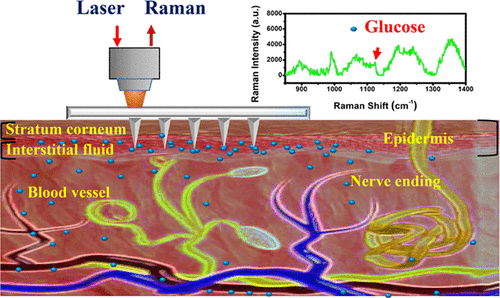Our official English website, www.x-mol.net, welcomes your feedback! (Note: you will need to create a separate account there.)
Surface Enhanced Raman Spectroscopy Based Biosensor with a Microneedle Array for Minimally Invasive In Vivo Glucose Measurements.
ACS Sensors ( IF 8.9 ) Pub Date : 2020-05-19 , DOI: 10.1021/acssensors.0c00444 Jian Ju 1, 2 , Chao-Mao Hsieh 1 , Yao Tian 1, 3 , Jian Kang 1 , Ruining Chia 4 , Hao Chang 1 , Yanru Bai 1 , Chenjie Xu 1, 5 , Xiaomeng Wang 4, 6, 7, 8 , Quan Liu 1
ACS Sensors ( IF 8.9 ) Pub Date : 2020-05-19 , DOI: 10.1021/acssensors.0c00444 Jian Ju 1, 2 , Chao-Mao Hsieh 1 , Yao Tian 1, 3 , Jian Kang 1 , Ruining Chia 4 , Hao Chang 1 , Yanru Bai 1 , Chenjie Xu 1, 5 , Xiaomeng Wang 4, 6, 7, 8 , Quan Liu 1
Affiliation

|
To monitor blood glucose levels reliably, diabetic patients usually have to undergo frequent fingerstick tests to draw out fresh blood, which is painful and inconvenient with the potential risk of cross contamination especially when the lancet is reused or not properly sterilized. This work reports a novel surface-enhanced Raman spectroscopy (SERS) sensor for the in situ intradermal detection of glucose based on a low-cost poly(methyl methacrylate) microneedle (PMMA MN) array. After incorporating 1-decanethiol (1-DT) onto the silver-coated array surface, the sensor was calibrated in the range of 0–20 mM in skin phantoms then tested for the in vivo quantification of glucose in a mouse model of streptozocin (STZ)-induced type I diabetes. The results showed that the functional poly(methyl methacrylate) microneedle (F-PMMA MN) array was able to directly measure glucose in the interstitial fluid (ISF) in a few minutes and retain its structural integrity without swelling. The Clarke error grid analysis of measured data indicated that 93% of the data points lie in zones A and B. Moreover, the MN array exhibited minimal invasiveness to the skin as the skin recovered well without any noticeable adverse reaction in 10 min after measurements. With further improvement and proper validation, this polymeric MN array-based SERS biosensor has the potential to be used in painless glucose monitoring of diabetic patients in the future.
中文翻译:

具有微针阵列的基于表面增强拉曼光谱的生物传感器,用于微创体内葡萄糖测量。
为了可靠地监测血糖水平,糖尿病患者通常必须频繁地进行指尖测试以抽出新鲜血液,这特别痛苦并且不易引起交叉污染的潜在交叉污染的风险,尤其是当柳叶刀被重新使用或未正确消毒时。这项工作报告了一种新型的表面增强拉曼光谱(SERS)传感器,用于基于低成本聚甲基丙烯酸甲酯微针(PMMA MN)阵列的皮内葡萄糖原位检测。将1-癸烷硫醇(1-DT)掺入涂银的阵列表面后,在皮肤模型中将传感器校准在0–20 mM的范围内,然后进行体内测试链脲佐菌素(STZ)诱导的I型糖尿病小鼠模型中葡萄糖的定量分析。结果表明,功能性聚甲基丙烯酸甲酯微针(F-PMMA MN)阵列能够在几分钟内直接测量组织液(ISF)中的葡萄糖,并保持其结构完整性而不会膨胀。测量数据的Clarke误差网格分析表明93%的数据点位于区域A和B中。此外,MN阵列对皮肤的侵袭性最小,因为在测量后10分钟内皮肤恢复良好,没有任何明显的不良反应。随着进一步的改进和适当的验证,这种基于聚合物MN阵列的SERS生物传感器有潜力在将来用于糖尿病患者的无痛血糖监测。
更新日期:2020-06-26
中文翻译:

具有微针阵列的基于表面增强拉曼光谱的生物传感器,用于微创体内葡萄糖测量。
为了可靠地监测血糖水平,糖尿病患者通常必须频繁地进行指尖测试以抽出新鲜血液,这特别痛苦并且不易引起交叉污染的潜在交叉污染的风险,尤其是当柳叶刀被重新使用或未正确消毒时。这项工作报告了一种新型的表面增强拉曼光谱(SERS)传感器,用于基于低成本聚甲基丙烯酸甲酯微针(PMMA MN)阵列的皮内葡萄糖原位检测。将1-癸烷硫醇(1-DT)掺入涂银的阵列表面后,在皮肤模型中将传感器校准在0–20 mM的范围内,然后进行体内测试链脲佐菌素(STZ)诱导的I型糖尿病小鼠模型中葡萄糖的定量分析。结果表明,功能性聚甲基丙烯酸甲酯微针(F-PMMA MN)阵列能够在几分钟内直接测量组织液(ISF)中的葡萄糖,并保持其结构完整性而不会膨胀。测量数据的Clarke误差网格分析表明93%的数据点位于区域A和B中。此外,MN阵列对皮肤的侵袭性最小,因为在测量后10分钟内皮肤恢复良好,没有任何明显的不良反应。随着进一步的改进和适当的验证,这种基于聚合物MN阵列的SERS生物传感器有潜力在将来用于糖尿病患者的无痛血糖监测。



























 京公网安备 11010802027423号
京公网安备 11010802027423号